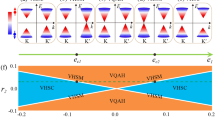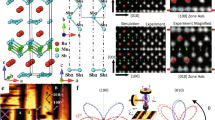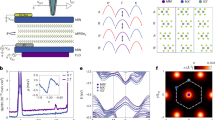Abstract
The electronic structure of certain crystal lattices can contain multiple degenerate ’valleys’ for their charge carriers to occupy. This valley degree of freedom could be useful in the development of electronic devices. The principal challenge in the development of ’valleytronics’ is to lift the valley degeneracy of charge carriers in a controlled way. Here we show that in semi-metallic bismuth the flow of Dirac fermions along the trigonal axis is extremely sensitive to the orientation of in-plane magnetic field. Thus, a rotatable magnetic field can be used as a valley valve to tune the contribution of each valley to the total conductivity. At high temperature and low magnetic field, bismuth’s three valleys are interchangeable and the three-fold symmetry of its lattice is maintained. As the temperature is decreased or the magnetic field increased, this symmetry is spontaneously lost. This loss may be an experimental manifestation of the recently proposed valley-nematic Fermi liquid state.
This is a preview of subscription content, access via your institution
Access options
Subscribe to this journal
Receive 12 print issues and online access
$209.00 per year
only $17.42 per issue
Buy this article
- Purchase on Springer Link
- Instant access to full article PDF
Prices may be subject to local taxes which are calculated during checkout






Similar content being viewed by others
References
Rycerz, A., Tworzydlo, J. & Beenakker, C. W. J. Valley filter and valley valve in graphene. Nature Phys. 3, 172–175 (2007).
Xiao, D., Yao, W. & Niu, Q. Valley-contrasting physics in graphene: Magnetic moment and topological transport. Phys. Rev. Lett. 99, 236809 (2007).
Min, H., Borghi, G., Polini, M. & MacDonald, A. H. Pseudospin magnetism in graphene. Phys. Rev. B 77, 041407 (2008).
Gunlycke, D. & White, C. T. Graphene valley filter using a line defect. Phys. Rev. Lett. 106, 136806 (2011).
Shayegan, M., De Poortere, E. P., Gunawan, O., Shkolnikov, Y. P., Tutuc, E. & Vakili, K. Two-dimensional electrons occupying multiple valleys in AlAs. Phys. Status Solidi B 243, 3629–3642 (2006).
Bishop, N. C., Padmanabhan, M., Vakili, K., Shkolnikov, Y. P., De Poortere, E. P. & Shayegan, M. Valley polarization and susceptibility of composite fermions around a filling factor ν=3/2. Phys. Rev. Lett. 98, 266404 (2007).
Eng, K., McFarland, R. N. & Kane, B. E. Integer quantum Hall effect on a six-valley hydrogen-passivated silicon (111) surface. Phys. Rev. Lett. 99, 016801 (2007).
Takashina, K, Ono, Y., Fujiwara, A., Takahashi, Y. & Hirayama, Y. Valley polarization in Si(100) at zero magnetic field. Phys. Rev. Lett. 96, 236801 (2006).
Abanin, D. A., Parameswaran, S. A., Kivelson, S. A. & Sondhi, S. L. Nematic valley ordering in quantum Hall systems. Phys. Rev. B 82, 035428 (2010).
Edelman, V. S. Electrons in bismuth. Adv. Phys. 25, 555–613 (1976).
Liu, Y. & Allen, R. E. Electronic structure of the semimetals Bi and Sb. Phys. Rev. B 52, 1566–1577 (1995).
Wolff, P. A. Matrix elements and selection rules for the two-band model of bismuth. J. Phys. Chem. Solids 25, 1057–1068 (1964).
McClure, J. W. The energy band model for bismuth: Resolution of a theoretical discrepancy. J. Low Temp. Phys. 25, 527–540 (1976).
Vecchi, M. P., Pereira, J. R. & Dresselhaus, M. S. Anomalies in the magnetoreflection spectrum of bismuth in the low-quantum-number limit. Phys. Rev. B 14, 298317 (1976).
Zhu, Z., Fauqué, B., Fuseya, Y. & Behnia, K. Angle-resolved Landau spectrum of electrons and holes in bismuth. Phys. Rev. B 84, 115137 (2011).
Behnia, K., Balicas, L. & Kopelevich, Y. Signatures of electron fractionalization in ultraquantum bismuth. Science 317, 1729–1731 (2007).
Li, L. et al. Phase transitions of Dirac electrons in bismuth. Science 321, 547–550 (2008).
Yang, H., Fauqué, B., Malone, L., Antunes, A. B., Zhu, Z. & Behnia, K. Phase diagram of bismuth in the extreme quantum limit. Nature Commun. 1, 47 (2010).
Alicea, J. & Balents, L. Bismuth in strong magnetic fields: Unconventional Zeeman coupling and correlation effects. Phys. Rev. B 79, 241101 (2009).
Sharlai Yu, V. & Mikitik, G. P. Origin of the peaks in the Nernst coefficient of bismuth in strong magnetic fields. Phys. Rev. B 79, 081102 (2009).
Du, X., Tsai, S-W., Maslov, D. L. & Hebard, A. F. Metal–insulator-like behavior in semimetallic bismuth and graphite. Phys. Rev. Lett. 94, 166601 (2005).
Hartman, R. Temperature dependence of the low-field galvanomagnetic coefficients of bismuth. Phys. Rev. 181, 1070–1086 (1969).
Mase, S., von Molnar, S. & Lawson, A. W. Galvanometric tensor of bismuth at 20.4 K. Phys. Rev. 127, 1030–1045 (1962).
Ziman, J. M. Electrons and phonons (Oxford Univ. Press, 1960).
Ast, C. R. & Höchst, H. Fermi surface of Bi(111) measured by photoemission spectroscopy. Phys. Rev. Lett. 87, 177602 (2001).
Fradkin, E., Kivelson, S. A., Lawler, M. J., Eisenstein, J. P. & Mackenzie, A. P. Nematic Fermi fluids in condensed matter physics. Annu. Rev. Condens. Matter Phys. 1, 153–178 (2010).
Lilly, M. P., Cooper, K. B., Eisenstein, J. P., Pfeiffer, L. N. & West, K. W. Evidence for an anisotropic state of two-dimensional electrons in high Landau levels. Phys. Rev. Lett. 82, 394–397 (1999).
Borzi, R. A. et al. Formation of a nematic fluid at high fields in Sr3Ru2O7 . Science 315, 214–217 (2007).
Okazaki, R. et al. Rotational symmetry breaking in the hidden-order phase of URu2Si2 . Science 331, 439–442 (2011).
Acknowledgements
We thank Y. Fuseya, A. J. Millis and N. P. Ong for discussions. This work is supported by ANR as part of DELICE and QUANTHERM projects and by a grant attributed by the Ile de France regional council. W.K. is supported by the government of Korea through NRF of Korea Grants (2011-0000982, 0018744, 0019893). We also acknowledge STAR, a France-Korea collaboration program.
Author information
Authors and Affiliations
Contributions
Z.Z. and A.C. (assisted by B.F.) carried out the measurements and (assisted by K.B. and B.F.) analysed the data. W.K. made the set-up and obtained the data leading to Fig. 5. K.B. led the project and wrote the paper.
Corresponding author
Ethics declarations
Competing interests
The authors declare no competing financial interests.
Supplementary information
Supplementary Information
Supplementary Information (PDF 1290 kb)
Rights and permissions
About this article
Cite this article
Zhu, Z., Collaudin, A., Fauqué, B. et al. Field-induced polarization of Dirac valleys in bismuth. Nature Phys 8, 89–94 (2012). https://doi.org/10.1038/nphys2111
Received:
Accepted:
Published:
Issue Date:
DOI: https://doi.org/10.1038/nphys2111



